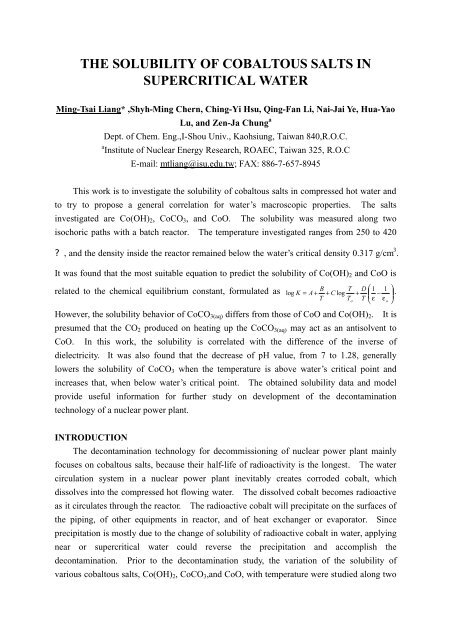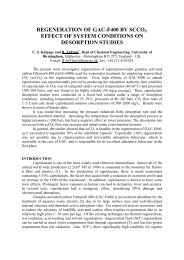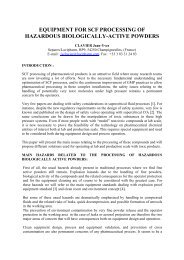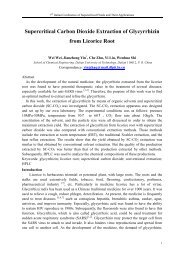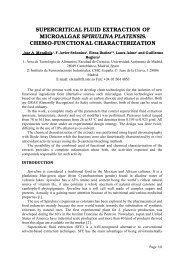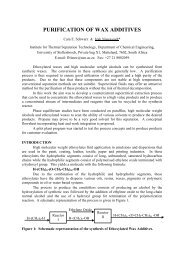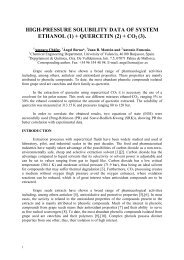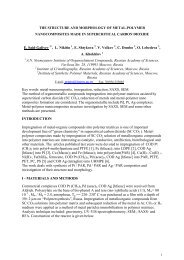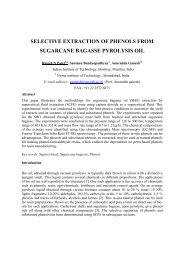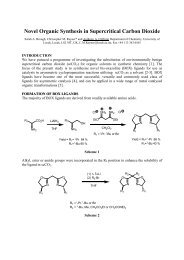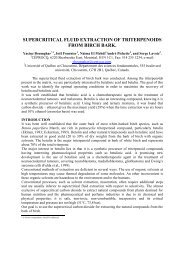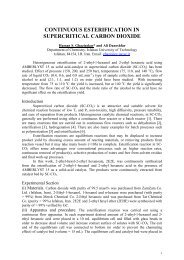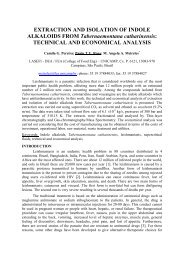The solubility of cobaltic salts in supercritical water. - ISASF
The solubility of cobaltic salts in supercritical water. - ISASF
The solubility of cobaltic salts in supercritical water. - ISASF
You also want an ePaper? Increase the reach of your titles
YUMPU automatically turns print PDFs into web optimized ePapers that Google loves.
THE SOLUBILITY OF COBALTOUS SALTS IN<br />
SUPERCRITICAL WATER<br />
M<strong>in</strong>g-Tsai Liang* ,Shyh-M<strong>in</strong>g Chern, Ch<strong>in</strong>g-Yi Hsu, Q<strong>in</strong>g-Fan Li, Nai-Jai Ye, Hua-Yao<br />
Lu, and Zen-Ja Chung a<br />
Dept. <strong>of</strong> Chem. Eng.,I-Shou Univ., Kaohsiung, Taiwan 840,R.O.C.<br />
a Institute <strong>of</strong> Nuclear Energy Research, ROAEC, Taiwan 325, R.O.C<br />
E-mail: mtliang@isu.edu.tw; FAX: 886-7-657-8945<br />
This work is to <strong>in</strong>vestigate the <strong>solubility</strong> <strong>of</strong> cobaltous <strong>salts</strong> <strong>in</strong> compressed hot <strong>water</strong> and<br />
to try to propose a general correlation for <strong>water</strong>’s macroscopic properties. <strong>The</strong> <strong>salts</strong><br />
<strong>in</strong>vestigated are Co(OH) 2 , CoCO 3 , and CoO. <strong>The</strong> <strong>solubility</strong> was measured along two<br />
isochoric paths with a batch reactor. <strong>The</strong> temperature <strong>in</strong>vestigated ranges from 250 to 420<br />
? , and the density <strong>in</strong>side the reactor rema<strong>in</strong>ed below the <strong>water</strong>’s critical density 0.317 g/cm 3 .<br />
It was found that the most suitable equation to predict the <strong>solubility</strong> <strong>of</strong> Co(OH) 2 and CoO is<br />
related to the chemical equilibrium constant, formulated as<br />
B T D ⎛ 1 1 ⎞<br />
log K = A + + C log + ⎜ ⎟<br />
− .<br />
T T<br />
o<br />
T ⎝ ε ε<br />
o ⎠<br />
However, the <strong>solubility</strong> behavior <strong>of</strong> CoCO 3(aq) differs from those <strong>of</strong> CoO and Co(OH) 2 . It is<br />
presumed that the CO 2 produced on heat<strong>in</strong>g up the CoCO 3(aq) may act as an antisolvent to<br />
CoO. In this work, the <strong>solubility</strong> is correlated with the difference <strong>of</strong> the <strong>in</strong>verse <strong>of</strong><br />
dielectricity. It was also found that the decrease <strong>of</strong> pH value, from 7 to 1.28, generally<br />
lowers the <strong>solubility</strong> <strong>of</strong> CoCO 3 when the temperature is above <strong>water</strong>’s critical po<strong>in</strong>t and<br />
<strong>in</strong>creases that, when below <strong>water</strong>’s critical po<strong>in</strong>t. <strong>The</strong> obta<strong>in</strong>ed <strong>solubility</strong> data and model<br />
provide useful <strong>in</strong>formation for further study on development <strong>of</strong> the decontam<strong>in</strong>ation<br />
technology <strong>of</strong> a nuclear power plant.<br />
INTRODUCTION<br />
<strong>The</strong> decontam<strong>in</strong>ation technology for decommission<strong>in</strong>g <strong>of</strong> nuclear power plant ma<strong>in</strong>ly<br />
focuses on cobaltous <strong>salts</strong>, because their half-life <strong>of</strong> radioactivity is the longest. <strong>The</strong> <strong>water</strong><br />
circulation system <strong>in</strong> a nuclear power plant <strong>in</strong>evitably creates corroded cobalt, which<br />
dissolves <strong>in</strong>to the compressed hot flow<strong>in</strong>g <strong>water</strong>. <strong>The</strong> dissolved cobalt becomes radioactive<br />
as it circulates through the reactor. <strong>The</strong> radioactive cobalt will precipitate on the surfaces <strong>of</strong><br />
the pip<strong>in</strong>g, <strong>of</strong> other equipments <strong>in</strong> reactor, and <strong>of</strong> heat exchanger or evaporator. S<strong>in</strong>ce<br />
precipitation is mostly due to the change <strong>of</strong> <strong>solubility</strong> <strong>of</strong> radioactive cobalt <strong>in</strong> <strong>water</strong>, apply<strong>in</strong>g<br />
near or <strong>supercritical</strong> <strong>water</strong> could reverse the precipitation and accomplish the<br />
decontam<strong>in</strong>ation. Prior to the decontam<strong>in</strong>ation study, the variation <strong>of</strong> the <strong>solubility</strong> <strong>of</strong><br />
various cobaltous <strong>salts</strong>, Co(OH) 2 , CoCO 3 ,and CoO, with temperature were studied along two
isochoric paths with a batch reactor. In this work, we measured the <strong>solubility</strong> <strong>of</strong> cobaltous<br />
<strong>salts</strong> <strong>in</strong> <strong>water</strong> to evaluate the feasibility <strong>of</strong> decontam<strong>in</strong>ation by near or <strong>supercritical</strong> <strong>water</strong>.<br />
<strong>The</strong> literature was scarce for the <strong>solubility</strong> <strong>of</strong> metal oxides and <strong>salts</strong> <strong>in</strong> high temperature<br />
<strong>water</strong>. Recently, the <strong>supercritical</strong> <strong>water</strong> oxidation process has been demonstrated to be an<br />
effective process to destruct hazardous wastes and municipal sludge. Although the<br />
commercialization <strong>of</strong> the SCWO process is on its way, the formation <strong>of</strong> solid <strong>salts</strong> will h<strong>in</strong>der<br />
its application. To further commercialize the SCWO process, the phase behavior <strong>of</strong> some<br />
<strong>salts</strong> commonly met <strong>in</strong> SCWO process was studied. Based on the data available <strong>in</strong> literature,<br />
Anderko has developed an equation <strong>of</strong> state for the salt solution. Extension <strong>of</strong> Anderko’s<br />
equation to ternary system is also possible [1]. Other than the salt solutions, a series <strong>of</strong><br />
researches done by Tohoku University <strong>in</strong> Japan showed the feasibility <strong>of</strong> produc<strong>in</strong>g<br />
nano-particles <strong>of</strong> metal oxides <strong>in</strong> <strong>supercritical</strong> <strong>water</strong> [2]. In order to control the size and<br />
distribution <strong>of</strong> the particles and to understand the nucleation mechanism, the <strong>solubility</strong> <strong>of</strong><br />
metal oxides should be measured prior to further study and commercialization. Due to lack<br />
<strong>of</strong> phase equilibrium data <strong>of</strong> metal oxides, no satisfactory generalized equation <strong>of</strong> state is<br />
available to predict the <strong>solubility</strong> <strong>of</strong> metal oxides <strong>in</strong> <strong>supercritical</strong> <strong>water</strong>. However, an<br />
empirical equation can be obta<strong>in</strong>ed when the <strong>solubility</strong> data found <strong>in</strong> literatures are employed<br />
to correlate with <strong>water</strong>’s macroscopic properties, such as density, pH, or dielectric constant.<br />
Simonson et al. and Ziemniak et al. used the follow<strong>in</strong>g equation to predict the <strong>solubility</strong> <strong>of</strong><br />
metal oxide <strong>in</strong> <strong>water</strong> [3, 4];<br />
B<br />
ln[ MO<br />
x<br />
⋅ nH<br />
2O]<br />
= A + + C lnT<br />
+ D ln ρ<br />
(1)<br />
T<br />
In this work, the <strong>solubility</strong> <strong>of</strong> cobaltous hydrate, cobaltous oxide, and cobaltous carbonate <strong>in</strong><br />
hot compressed <strong>water</strong> is measured and correlated via equation (1). However s<strong>in</strong>ce the <strong>salts</strong><br />
and oxides will form complex or hydrate <strong>in</strong> the presence <strong>of</strong> <strong>water</strong>, the chemical equilibrium<br />
among them need be considered before satisfactory correlation can be obta<strong>in</strong>ed. For<br />
cobaltous hydrate, the <strong>solubility</strong> is attributable to the four possible routes,<br />
Co(OH) 2(s) D Co(OH) 2(aq) K 1<br />
Co(OH) 2(s) D Co(OH) + + OH - K 2<br />
Co(OH) 2(s) D Co 2+ + 2OH - K 3<br />
Co(OH) 2(s) + OH - D Co(OH) - 3 K 4<br />
<strong>The</strong>refore the total <strong>solubility</strong> <strong>of</strong> cobaltous ions <strong>in</strong> <strong>supercritical</strong> <strong>water</strong> can be expressed as<br />
+ 2+<br />
−<br />
{[ Co(OH) ] + [ Co(OH) ] + [ Co ] + [ Co(OH) ]}<br />
C T<br />
( ppm)<br />
=<br />
2(aq)<br />
3<br />
× 58.93/1000<br />
⎪⎧<br />
2<br />
3<br />
⎪⎫<br />
(2)<br />
K K<br />
−<br />
= ⎨K1<br />
+ + + K4<br />
[ ]<br />
[ OH ] × 58.93/ 1000<br />
−<br />
2 ⎬<br />
⎪⎩ OH<br />
−<br />
[ OH ] ⎪⎭
Arai et al. has shown that the chemical equilibrium constants depend strongly on <strong>water</strong>’s<br />
properties, which can be correlated as [5]<br />
o<br />
o ∆H<br />
( To<br />
, ρ ) ⎛ 1 1 ⎞ ∑ w<br />
o<br />
i i ⎛ 1 1 ⎞<br />
ln K(<br />
T,<br />
ρ ) = −ln<br />
K ( To<br />
, ρ ) +<br />
⎜ −<br />
⎟ +<br />
⎜ −<br />
⎟<br />
(3)<br />
o<br />
R ⎝ T To<br />
⎠ T ⎝ ε(<br />
T,<br />
ρ)<br />
ε(<br />
To<br />
, ρo<br />
) ⎠<br />
For the purpose <strong>of</strong> regression, the equation is rewritten as<br />
B T D ⎛ 1 1 ⎞<br />
log K = A + + C log +<br />
⎜ −<br />
⎟<br />
(4)<br />
T To<br />
T ⎝ ε ε<br />
o ⎠<br />
<strong>The</strong> macroscopic properties <strong>of</strong> <strong>water</strong> can be calculated based on the observed pressure and<br />
temperature. In this work the density <strong>of</strong> <strong>water</strong> was calculated with Patel-Teja equation <strong>of</strong><br />
state [6], and the dielectricity and the ionic product were calculated with the regression<br />
equations derived by Uematsu and Franck [7] and by Marashall and Franck [8], respectively.<br />
EXPERIMENTS AND METHODS<br />
Water (25 or 30g) and various cobaltous <strong>salts</strong> (0.1g) were loaded <strong>in</strong>to a high pressure<br />
vessel. <strong>The</strong> vessel is made <strong>of</strong> SS 316L with <strong>in</strong>ternal volume <strong>of</strong> 124 ml and equipped with a<br />
pressure gauge, a relief vale, and a filter connected to the sampl<strong>in</strong>g system. <strong>The</strong> loaded<br />
vessel is placed <strong>in</strong> a furnace and heated-up to the designated temperature. In the present<br />
work the temperature <strong>of</strong> the furnace studied ranged from 280 o C to 420 o C. Normally, the<br />
pressure <strong>in</strong> the vessel exhibited a maximum after about 30 m<strong>in</strong>utes <strong>of</strong> heat<strong>in</strong>g, and leveled <strong>of</strong>f<br />
to the maximum as the heat<strong>in</strong>g cont<strong>in</strong>ued. <strong>The</strong> reaction <strong>in</strong> the vessel was allowed to carry<br />
on for an additional period <strong>of</strong> about 60 m<strong>in</strong>utes after the maximum pressure was first<br />
observed. <strong>The</strong> reaction was then term<strong>in</strong>ated by open<strong>in</strong>g the relief valve. <strong>The</strong> effluent was<br />
filtrated and collected <strong>in</strong> a sampl<strong>in</strong>g system, which is composed <strong>of</strong> a sample cyl<strong>in</strong>der and a<br />
needle valve. <strong>The</strong> cobaltous content <strong>of</strong> the collected liquid effluent was analyzed by an AA.<br />
<strong>The</strong> batch reactor used <strong>in</strong> this work follows an isochoric path, and the f<strong>in</strong>al pressure is <strong>in</strong><br />
theory predictable for pure <strong>water</strong>. However, the presence <strong>of</strong> <strong>salts</strong>, decomposed gases and<br />
condensed liquids <strong>in</strong> the connector and the tube outside the furnace may render the pressure<br />
to deviate significantly from the prediction. <strong>The</strong>refore the observed maximum pressure and<br />
the temperature <strong>of</strong> the furnace were used to characterize the state <strong>of</strong> the <strong>water</strong>. From the<br />
pressure and temperature, the macroscopic properties <strong>of</strong> <strong>water</strong> such as density, pH, and<br />
dielectricity were calculated and correlated with the <strong>solubility</strong> data <strong>of</strong> <strong>salts</strong> and metal oxides.<br />
RESULTS AND DISCUSSION<br />
<strong>The</strong> Solubility <strong>of</strong> Co(OH) 2<br />
Figure 1 shows the <strong>in</strong>fluence <strong>of</strong> temperature on the <strong>solubility</strong> <strong>of</strong> Co(OH) 2 along an<br />
isobaric path, <strong>in</strong> which 25 g <strong>of</strong> <strong>water</strong> and 0.1 g <strong>of</strong> Co(OH) 2 were placed <strong>in</strong> a 124-ml reactor.<br />
<strong>The</strong> circles represent the experimental results, and the solid l<strong>in</strong>e is the regression l<strong>in</strong>e with<br />
equations (2) and (4). Equation (1) was also used to fit the experimental results; however,
no good fit was found. On apply<strong>in</strong>g equations (2) and (4), sixteen parameters were needed<br />
to fit the seven experimental data. S<strong>in</strong>ce the contribution <strong>of</strong> Co(OH) + and Co 2+ is m<strong>in</strong>or,<br />
only the contribution <strong>of</strong> Co(OH) 2(aq) and Co(OH) - 3 to the <strong>solubility</strong> is accounted for <strong>in</strong> this<br />
work. <strong>The</strong> parameters used for the chemical equilibrium constant are listed <strong>in</strong> Table 1, and<br />
the contribution <strong>of</strong> Co(OH) 2(aq) and Co(OH) - 3 is also depicted <strong>in</strong> Figure 2. It is observed<br />
that the <strong>solubility</strong> is mostly contributed by Co(OH) - 3 when the temperature is below <strong>water</strong>’s<br />
critical po<strong>in</strong>t, and mostly contributed by Co(OH) 2(aq) when, above <strong>water</strong>’s critical po<strong>in</strong>t.<br />
<strong>The</strong> same parameters employed <strong>in</strong> Figure 1 was also applied to another experiment with 30 g<br />
<strong>of</strong> <strong>water</strong> and 0.1 g <strong>of</strong> Co(OH) 2 <strong>in</strong> a 124-ml reactor. Both experimental and calculated<br />
results are also shown <strong>in</strong> Figure 3. Although the fit is not as good as that <strong>of</strong> Figure 1, the<br />
trend is predicted adequately. Further study on generalized parameters will improve the fit.<br />
50<br />
100<br />
Solubility (ppm)<br />
40<br />
30<br />
20<br />
Solubility (ppm)<br />
10<br />
1<br />
10<br />
0.1<br />
250 300 350 400 450<br />
Temperature (C)<br />
0.01<br />
250 300 350 400 450<br />
Temperature (C)<br />
Figure 1 <strong>The</strong> <strong>solubility</strong> <strong>of</strong> Co(OH) 2 along<br />
isobaric path; 25 g <strong>of</strong> <strong>water</strong> and 0.1 g <strong>of</strong><br />
Co(OH) 2 <strong>in</strong> 124 ml vessel.<br />
Figure 2 <strong>The</strong> contribution <strong>of</strong> Co(OH) 2(aq) ,<br />
symbolized as ×, and Co(OH) 3<br />
- ,<br />
symbolized as ?, to the total <strong>solubility</strong>.<br />
<strong>The</strong> Solubility <strong>of</strong> CoCO 3<br />
<strong>The</strong> <strong>solubility</strong> <strong>of</strong> CoCO 3 along two isobaric paths is shown <strong>in</strong> Figure 4. <strong>The</strong> trend <strong>of</strong><br />
the experimental data is roughly consistent with 1/ε – 1/ε o . For each isobaric path an<br />
<strong>in</strong>dividual empirical equation can be found by correlat<strong>in</strong>g with the difference <strong>of</strong> the <strong>in</strong>verse<br />
<strong>of</strong> dielectricity, however, no general empirical equation was obta<strong>in</strong>ed <strong>in</strong> this work. <strong>The</strong><br />
empirical correlations are
⎧ ⎛ 1 1 ⎞<br />
⎪ln(<br />
S)<br />
= 7.67<br />
⎜ −<br />
⎟ + 1.32;<br />
⎪ ⎝ ε ε<br />
o ⎠<br />
⎨<br />
⎪ ⎛ 1 1 ⎞<br />
⎪<br />
ln( S)<br />
= 8.73<br />
⎜ −<br />
⎟ + 2.05;<br />
⎩ ⎝ ε ε<br />
o ⎠<br />
25 g <strong>of</strong> <strong>water</strong> and 0.1g <strong>of</strong> CoCO<br />
30 g <strong>of</strong> <strong>water</strong> and 0.1g <strong>of</strong> CoCO<br />
3<br />
3<br />
<strong>in</strong> 124 ml<br />
(5)<br />
<strong>in</strong> 124 ml<br />
Other than the above empirical equations, equations (1) and (4) were also applied to<br />
correlat<strong>in</strong>g the experimental data. Neither equation (1) nor equation (4) can obta<strong>in</strong> a<br />
general correlation. It is presumed that carbon dioxide formed dur<strong>in</strong>g the reaction may act<br />
as a cosolvent, thereby caus<strong>in</strong>g a change <strong>in</strong> acidity <strong>of</strong> <strong>water</strong>, which was not accounted for <strong>in</strong><br />
equations (1) and (4). Studies on the effect <strong>of</strong> carbon dioxide on the <strong>solubility</strong> <strong>of</strong> carbonate<br />
near <strong>water</strong>’s critical po<strong>in</strong>t are rare. <strong>The</strong>refore, it is difficult to obta<strong>in</strong> a general correlation at<br />
this moment.<br />
Table 1 <strong>The</strong> parameters <strong>of</strong> the chemical equilibrium constant <strong>in</strong> formation <strong>of</strong> complexes<br />
K A B C D<br />
Co(OH) 2(aq) +<br />
Co(OH) 3<br />
8.5<br />
7.6<br />
-3800<br />
-9010<br />
0.02<br />
0.16<br />
3000<br />
6350<br />
40<br />
50<br />
Solubility (ppm)<br />
30<br />
20<br />
Solubility (ppm)<br />
40<br />
30<br />
20<br />
10<br />
10<br />
300 320 340 360 380 400 420<br />
Temperature (C)<br />
0<br />
300 320 340 360 380 400 420<br />
Temperature (C)<br />
Figure 3 <strong>The</strong> <strong>solubility</strong> <strong>of</strong> Co(OH) 2 along<br />
isobaric path; 30 g <strong>of</strong> <strong>water</strong> and 0.1 g <strong>of</strong><br />
Co(OH) 2 <strong>in</strong> 124 ml vessel.<br />
Figure 4 <strong>The</strong> <strong>solubility</strong> <strong>of</strong> CoCO 3 along<br />
isobaric path and their calculated results; ?:<br />
25 g <strong>of</strong> H 2 O and 0.1 g <strong>of</strong> CoCO 3 <strong>in</strong> vessel;<br />
?: 25 g <strong>of</strong> H 2 O and 0.1 g <strong>of</strong> CoCO 3 <strong>in</strong><br />
vessel.<br />
It is well known that the <strong>solubility</strong> <strong>of</strong> carbonate <strong>in</strong>creases with decreas<strong>in</strong>g pH. Instead<br />
<strong>of</strong> RO <strong>water</strong>, diluted HNO 3 aqueous solution (pH = 1.28) was used to study the <strong>solubility</strong> <strong>of</strong><br />
CoCO 3 <strong>in</strong> acidic aqueous solution. <strong>The</strong> results are illustrated <strong>in</strong> Figure 5 with symbol ×.<br />
<strong>The</strong> diamonds shown <strong>in</strong> Figure 5 are those reproduced from Figure 4 for comparison. <strong>The</strong>
decrease <strong>of</strong> pH promotes the <strong>solubility</strong> when the temperature is below critical po<strong>in</strong>t and<br />
depresses that when, above critical temperature.<br />
Table 2 <strong>The</strong> parameters <strong>of</strong> the equilibrium constant <strong>in</strong> formation <strong>of</strong> Co(OH) 2 from CoO.<br />
A B C D<br />
25 g <strong>of</strong> <strong>water</strong><br />
30 g <strong>of</strong> <strong>water</strong><br />
-7.0<br />
-9.5<br />
1780<br />
3600<br />
-0.4<br />
-0.6<br />
3200<br />
2300<br />
<strong>The</strong> Solubility <strong>of</strong> CoO<br />
S<strong>in</strong>ce CoO might form Co(OH) 2 <strong>in</strong> <strong>water</strong>, it is believed that the formation <strong>of</strong> cobaltous<br />
hydrate is the determ<strong>in</strong><strong>in</strong>g step. Accord<strong>in</strong>gly, the experimental data <strong>of</strong> each isochoric path<br />
were fitted with equation (4), but no general correlation was found. <strong>The</strong> fitted results are<br />
shown <strong>in</strong> Figure 6 and the parameters used are listed <strong>in</strong> Table 2. Further studies that take<br />
<strong>in</strong>to account the formation <strong>of</strong> complexes are undergo<strong>in</strong>g.<br />
CONCLUSION<br />
In this work we have measured the <strong>solubility</strong> <strong>of</strong> Co(OH) 2 , CoO, and CoCO 3 <strong>in</strong><br />
compressed hot <strong>water</strong> and correlated the experimental data with different model equations.<br />
<strong>The</strong> proposed empirical equations were determ<strong>in</strong>ed and illustrated <strong>in</strong> Figures 1 - 6. Among<br />
them a general equation to predict the <strong>solubility</strong> <strong>of</strong> Co(OH) 2 was obta<strong>in</strong>ed. It is presumed<br />
that a new model equation will be necessary to obta<strong>in</strong> general equations for CoCO 3 and CoO.<br />
60<br />
40<br />
50<br />
Solubility (ppm)<br />
40<br />
30<br />
20<br />
Solubility (ppm)<br />
30<br />
20<br />
10<br />
10<br />
0<br />
250 300 350 400 450<br />
Temperature (C)<br />
0<br />
250 300 350 400<br />
Temperature (C)<br />
Figure 5 <strong>The</strong> Solubility <strong>of</strong> CoCO 3 <strong>in</strong> Figure 6 <strong>The</strong> <strong>solubility</strong> <strong>of</strong> CoO along<br />
neutral and acidic <strong>water</strong>; ?: pH = 7; x: pH = isobaric path and their calculated results; ?:<br />
1.28.<br />
25 g <strong>of</strong> <strong>water</strong> and 0.1 g <strong>of</strong> CoO <strong>in</strong> 124 ml; ?:<br />
30 g <strong>of</strong> <strong>water</strong> and 0.1 g <strong>of</strong> CoO <strong>in</strong> 124 ml.<br />
REFERENCES:<br />
[1] ANDERKO, A, AND PITZER, K.S., Geochim. Cosmochim. Acta, Vol. 57, 1993,<br />
p.1657
[2] http://www.scw.che.tohoku.ac.jp/publication.html<br />
[3] SIMONSON, J.M., HOLMES, H.F., BUSEY, R.H., MESMER, R.E., ARCHER, D.G.<br />
AND WOOD, R.H., J. Phys. Chem. Vol. 94, 1990, p.7675<br />
[4] ZIEMNIAK, S., JONES, M., COMBS, K., J. Solution Chem., Vol. 27, No. 1, 1998, p.33<br />
[5] ARAI, K., “Supercritical Fluid Tech. & Its Application for Produc<strong>in</strong>g new Materials,”<br />
Invited Lecture <strong>in</strong> MIRDC, Taiwan, Dec. 26, 2000<br />
[6] GEORGETON, G. K., SMITH, R. L., and TEJA, A. S., ACS series 300, 1985, p.434<br />
[7] UEMATSU, M., AND FRANCK, E. U., J. Phys. Chem. Ref. Data, Vol. 9, 1980, p.1291<br />
[8] MARSHALL, W. L., FRANCK, E. U., J. Phys. Chem. Ref. Data, Vol. 10, 1981, p.295


